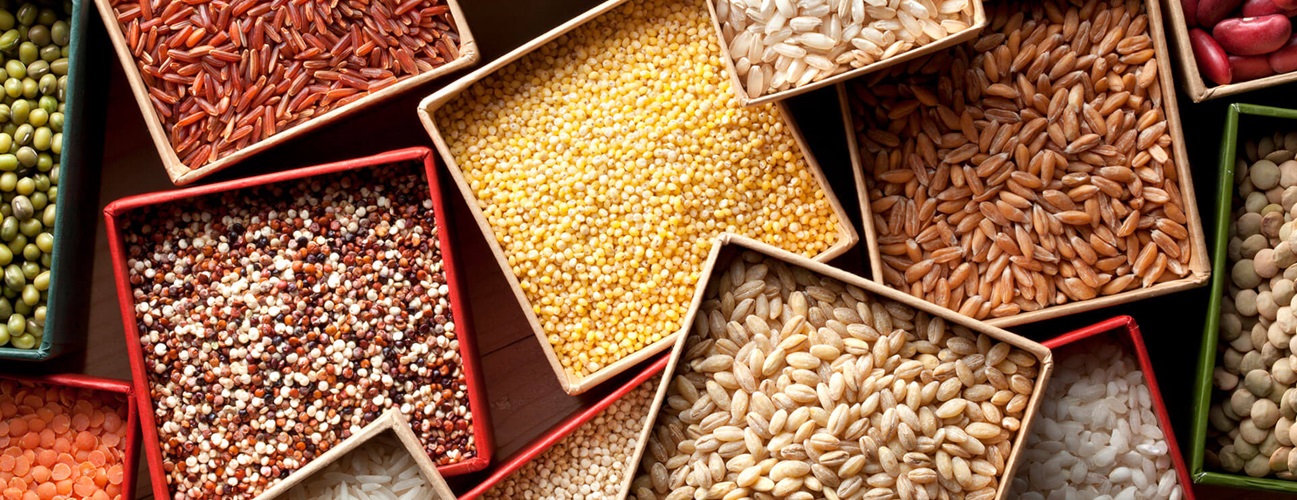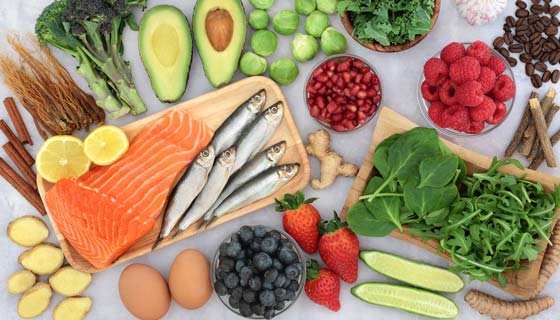Barley, Farro, Sorghum and More: 9 Whole Grains to Try
Featured Expert:
Whole grains have always been a staple of a healthy diet, and when you go to the market today, you’ll find plenty of choices — some of which you may not have tried yet.
Ashli Greenwald, a registered dietitian, explains what whole grains are and how they can improve your health, and provides tips on introducing new grains into your diet.
What is a whole grain?
“A whole grain is one that’s not processed,” Greenwald explains. “It’s eaten or prepared in its natural state, as it grows in the ground. That way, you get all its components: the bran, the germ and the endosperm, where all the fiber, minerals and healthy fats are.”
Processed and refined grain products are what shoppers are most likely to see in stores, she says. “Most commercial bread is made with grain that has had some of its components removed in processing so it lasts longer on the shelf, and typically has a spongy texture that is popular with American consumers. ‛Enriched’ flour has had some of the vitamins put back in, but it’s still not as healthy as eating whole grain flour and foods.”
Good Carbs: Whole Grain Health Benefits
After decades of avoiding “carbs,” people are rediscovering good (complex) carbohydrates, including whole grains. They’re good for you in several ways, Greenwald says.
Vitamins, Minerals and More
“Whole grains, as they’re grown in the ground, are full of nutrients,” she says. “They can contain several B vitamins and trace minerals, such as iron, zinc, magnesium and copper. Some whole grains are good sources of protein.
“You also get phytonutrients: plant-based compounds that can reduce inflammation and may lower your chances of developing heart disease, diabetes and even some kinds of cancer,” says Greenwald.
Gut Health and Weight Loss
Because they’re high in fiber, these foods help you feel full and satisfied, which can help you shed pounds. And, unlike refined carbs such as white flour, white bread, white pasta, pastries and other sweets, whole grains are less likely to cause a spike in blood sugar.
Soluble fiber in these grains may help you lower your cholesterol. It also slows down digestion so you feel fuller longer. As a bonus, soluble fiber can act as a prebiotic, providing nourishment for the good bacteria that keep your gut healthy.
The other kind of fiber, insoluble fiber from the husks of whole grains, supports bowel health and may prevent constipation, gallstones, hemorrhoids and other discomforts.
How many of these whole grains have you tried?
Some of these whole grains can be found on the shelves of large grocery stores. Others can be tracked down at smaller, specialty health food stores or organic markets. You can even order harder-to-find items online.
1. Amaranth
High-protein amaranth has been eaten in South America for thousands of years, and legend has it that the Aztecs referred to amaranth as the “food of immortality.” Greenwald recommends amaranth to her patients because it’s highly nutritious, gluten free and easy to bake with. “You can use the same amount of amaranth flour as regular flour in most recipes,” she says.
Tips for Amaranth Recipes
- You can pop amaranth like popcorn.
- Amaranth flour can work in gluten-free baking, such as muffins.
- The distinctive, slightly spicy flavor works well with corn and squash dishes, and pairs nicely with cinnamon in desserts.
2. Barley
Like wheat, barley comes from a plant that is part of the grass family. Whole grain barley (not “pearl”) has an appealing, nutlike flavor. It contains gluten, so if you have celiac disease, you’ll have to avoid it. Soaking or sprouting barley gives you even more benefit by making its nutrients more absorbable by the body.
Tips for Barley Recipes
- Bake some bread with sprouted barley flour — a nutritional powerhouse compared with plain flour.
- Add texture to soup with whole grain barley instead of white rice.
3. Bulgur
Bulgur, Greenwald explains, is cracked wheat that has been partially cooked and then dried. It’s the main ingredient in tabbouleh, a Middle Eastern dish flavored with mint, parsley and tomatoes. But it’s incredibly versatile, and its fast cooking time (10 minutes) makes it a nutritious go-to for busy people who want to incorporate whole grains into their diet.
Tips for Bulgur Recipes
- Bulgur is tasty with a simple dressing of lemon, olive oil, salt and pepper.
- It can be added to homemade veggie burgers or vegetarian chili.
- It makes a good filler for meatballs and meatloaves.
4. Farro
Farro refers to any one of three ancient grains from the Triticum family, first cultivated and eaten over 2,000 years ago. It is still popular in Tuscan and other Mediterranean cuisine. In addition to great taste, the large, whole-grain version of farro provides healthy fiber and protein. Its pleasantly chewy texture holds up well, even in soups and stews. The whole grain version of farro is more nutritious than the husked or “pearled” type.
Freekeh is another form of wheat. The grain is harvested while still green, and roasted for a superb flavor. It can be used in recipes calling for quinoa, wheatberries or farro.
Tips for Farro Recipes
- Soak whole grain farro overnight before cooking.
- Toss with kale and other veggies for a delicious salad.
- Add to soups or serve with a drizzle of olive oil and seasonings.
5. Millet
Millet — a tiny, hard grain — is the main ingredient in bird seed. However, it is also a protein-rich whole grain eaten by people in many countries around the world. Millet, as a crop, is lauded for its hardiness and ease of cultivation. In Chinese cooking, millet can be the basis of a hot, savory porridge called congee.
Tips for Millet Recipes
- Millet lends itself to Asian cuisine, and can be served instead of rice with stir-fry dishes.
- Try millet cooked and served hot as a breakfast cereal.
- It can be seasoned and pressed into patties for veggie burgers.
6. Whole Oats
Unlike the processed, sugar-laden flavor packets of instant oatmeal, whole oats or the steel-cut varieties give you all the benefits of this versatile grain. And it’s not just for breakfast anymore.
Tips for Whole Oat Recipes
- Enjoy whole oats for breakfast in hot cereal, muesli or muffins.
- Add fresh whole berries for antioxidant power.
- Try whole oats as a healthy alternative to breadcrumbs used as extenders in hamburgers or meatloaf.
7. Quinoa
Pronounced “KEEN-wah,” this versatile, gluten-free grain is actually an edible seed. It is a healthier substitute for white rice, and can be eaten as a hot breakfast dish, a base for salad, an addition to soup and much more. Greenwald points out that quinoa is a complete protein source, with all nine amino acids that our bodies need to obtain from foods we eat.
Tips for Quinoa Recipes
- There are over 100 kinds of quinoa. White and yellow types have the mildest taste; black quinoa has the most intense flavor.
- Be sure to rinse the quinoa thoroughly before cooking.
- When the pale quinoa hull begins to separate from the inside germ, it’s done.
8. Sorghum
What is sorghum? Like corn, it’s an essential whole grain used for making fuel and feeding animals and people, but takes far less water to cultivate and matures quickly, and so it is more environmentally friendly. Sorghum is originally from Africa, and first arrived on Southern American tables as an ingredient in molasses. It is chock full of antioxidants, vitamins and minerals, but no gluten. Each half-cup has 10 grams of protein, which makes it both nutritious and filling.
Tips for Sorghum Recipes
- Sorghum has roots in African heritage cuisine, and works well with Creole and Cajun dishes and flavors.
- Gourmet restaurants are using it in flatbreads and Spanish-style rice dishes.
- Try tossing it with dressing and veggies for a filling and nutritious salad or pita filling.
9. Teff
These tiny grains of goodness provide a mild, nutty flavor along with iron and other minerals. Teff flour is used to make injera, the flavorful flatbread used to scoop up stews in traditional Ethiopian and Eritrean cuisine. Because the gluten-free grains are so small, there is a high proportion of germ and bran, the most nutritious parts of whole grains.
Tips for Teff Recipes
- Greenwald says teff makes an excellent hot cereal, and can be prepared as a polenta or side dish.
- You can make an overnight porridge with teff by adding water and putting it in the refrigerator overnight.
- When prepared like rice, teff can be ready in 15 or 20 minutes.
Whole Grains and Gas
Some people hesitate to enjoy the benefits of whole grains because they’re concerned about bloating or intestinal gas. If your system isn’t used to healthy, high-fiber foods, Greenwald says introducing whole grains into your diet gradually can help avoid these symptoms. “Start with smaller servings,” she suggests, “and make sure you increase the amount of water you drink.”
Over time, you may notice healthier digestion. Once whole grains become a mainstay in your meals, you are more likely to avoid constipation, which is a common cause for intestinal gas and bloating.
Whole Grains and Your Healthy Diet
Greenwald says whole grains can add a lot of beneficial nutrients and flavor to your meals. “Mindfully incorporating whole grains into meals can maximize the health benefits they provide,” she says.
“Using healthy plate guidelines for portions, your serving of whole grains should take up about 25% of your plate, with lean protein taking up another 25% and vegetables covering the remaining half,” she recommends.







